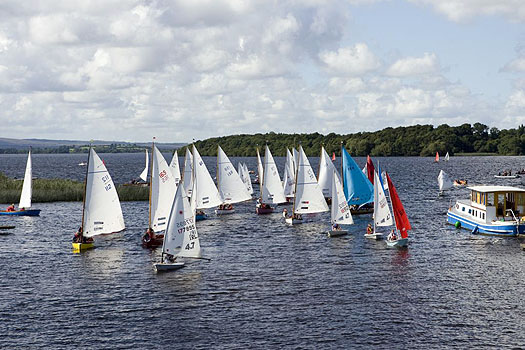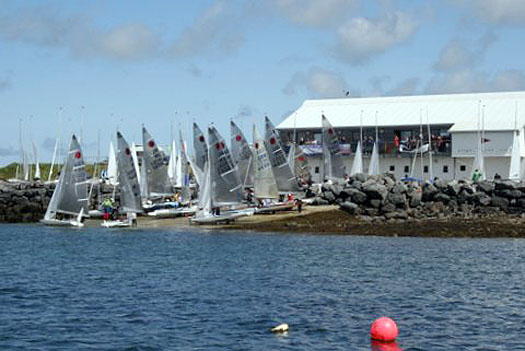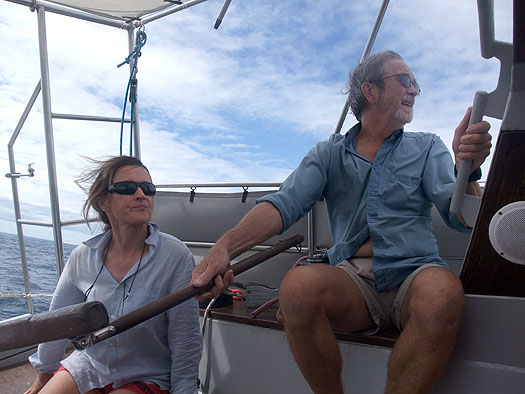#dinghy – General de Gaulle used to say that of course it was a very difficult job to govern France – what else would you expect in a country with 387 different cheeses? So when people talk of how difficult it seems to be to administer sailing at any level, the only answer is: what else would you expect of a sport with 143 World Championships?
Every class which has achieved international status is entitled to stage its own official World Championship, and boy do they cling to the privilege, even when the old boats are only hanging on by the skin of their teeth in two or three centres. As for the mind-boggling variety of those centres.....well, we just won't go there today.
Faced with this hyper-crazy kaleidoscope of dozens of very different boat types sailing in their many and often odd ways in what is a quintessential vehicle sport, casual public interest tends to focus only on the most expensive forms of sailing, or the sailing with the biggest public rows and scandals, or the sailing with the greatest danger, preferably with deaths now and again.
So that's the America's Cup, the Olympics, and the more extreme forms of offshore racing, all way ahead of the field The rest is of interest only to those taking part, their families, their friends if they still have any after becoming addicted to boats, and the occasional daft salthead like this blogger.

Hyper-crazy kaleidoscope – a variety of boats (with the Shannon One Designs dominant) return to port after racing at Dromineer on Lough Derg
Slipping even further under the radar of public interest are those who don't race but cruise, and those whose enthusiasm is for classic or traditional boats. We saltheads are interested in them and their boats too, but we don't expect the powers that be and the public at large to think of them (if they think of them at all) as anything other than a case of oddity just barely this side of certification.
Thus for the unfortunate folk who end up running the sailing show nationally and internationally, so diverse are the demands of the sailing population that they tend to keep their heads down, and follow the money. They'll know that those in government and disbursing public sports funding will tend to share the interests and attitudes of the general public.

When a World Championship comes to call at one of Ireland's friendly neighbourhood club – Fireballs at Sligo YC at Rosses Point for their Worlds last year Photo: Bryan Armstrong
So as far as Irish sailing national administration is concerned, there's an enormous hunger for international sailing medals, Olympic ones preferred. If we scratched hard enough, we'd probably find that their dearest wish is that there should be a restrospective Olympic Pewter Medal for being fourth – we'd be in line for a few of those, starting with Eric Strain in the Dragon Class way back in 1948.
Sailing in all its glorious variety is one very confused picture, accompanied by a hugely complex narrative. Thus the Olympics are a Godsend for administrators, as they act as a ferociously efficient editing process. The fact that the Laser is the only Olympic class which has anything approaching global popularity is neither here nor there. Once you get into bed with the simplified Olympic machine, that's it – normality is out the window, but at least the picture is more clearcut.
Even if the format of an Olympiad only every four years means that totally-dedicated Olympic atheletes are freaks, it's a freak show which provides sailing with a useful handle for making sense of itself, and communicating with the rest of the world. But when you throw modern celebrity culture into an already toxic mix, with young sailors being led to idolize only the top stars, there's inevitably trouble. Total concentration on what's going on at the top of the pyramid means that the structure is being neglected further down, and there's distress at grass roots.
It's this concern which was aired by Norman Lee of Wicklow and Lough Derg and Bryan Armstrong of Sligo at last weekend's ISA conference, and it will be aired again in what promises to be a robust gathering in the National YC on March 23rd. Bluntly, ordinary club dinghy sailors, the backbone of much of our sport, feel that their interests are being sidelined in pursuit of the top international awards, and they see ordinary club life suffering as the focus is narrowed on the glamour events and categories.
Is what they hope for attainable? Is it really possible to get young people passionately involved in, and committed to, sailing at the local level when all of today's media are bombarding them with images of superstars in glossy boats at glamorous locations?
Junior dinghy sailing at its best – Mirror racing at Sligo Photo: Bryan Armstrong
One particular concern is that the sport at club level seems to suffer its greatest loss among those between 16 and 24. But is sailing unique in this? Even in everyday family life, there's a natural estrangement at this age. As Mark Twain sagely remarked: "When I was 15, my father was clearly a complete idiot. But by the time I'd become 25, it was quite extraordinary how much good sense and wisdom the old fellow had since managed to acquire".
Maybe we should accept that we have to lose them for a while, but that if and when they return to sailing, it will be as adults making their own choice, and they'll be much more useful to their club and community as a result. And with any luck they'll have learned that life for 99.99% of us is not all about four year freak shows. Life is about humdrum everyday existence, and finding a certain enjoyment in it. For sure, there'll always be those aspiring for just one single day as an eagle, rather than a hundred years as a sheep. Yet for most of us, we must worship with the God of Small Things. But whether we can expect an allocation of respect, funding and resources for this is the topic for March 23rd.
OCEAN ACHIEVEMENT
The Ocean Cruising Club, international body for those who sail the Seven Seas, has awarded major trophies to Tim Severin (he lives in Courtmacsherry in West Cork these days) and Fergus and Kay Quinlan of Kinvara in County Galway.
The Quinlan achievement, a three year voyage around the world with their own-built steel cutter Pylades, was highlighted here three weeks ago when it took the Faulkner Cup, top trophy of the Irish Cruising Club, for the third year in a row. But recognition by the Ocean Cruising Club is a salute from an organisation which has played the leading role in long distance voyaging since 1954, and it reflects great credit on Pylades and her crew.

Living the Pacific cruising dream – Pylades at Nuka Hiva in the French Marquesas Photo: Fergus Quinlan

Voyaging couple: Kay and Fergus Quinlan sailing aboard Pylades off Moorea (don't tell anyone, but they were racing at the time)
Tim Severin's renowned re-enactments of ancient voyages in small and primitive craft first gained recognition with his re-creation of the Brendan voyage in a leather boat across the North Atlantic from West Kerry to North America by the northern route. He dramatically demonstrated that the long voyages of the Irish monks, assumed by many to be no more than the stuff of myth and legend, could indeed have been achieved with the boats and technology available at the time of St Brendan.

Tim Severin's St Brendan departing West Kerry at the start of the Transatlantic voyage in 1976. The "giant leather currach" was built in Crosshaven Boatyard
The founder of the Ocean Cruising Club, Humphrey Barton, had a long association with Ireland. In 1935 he raced in the Irish Cruising Club's offshore event from Howth to Peel in the Isle of Man. The winner of the stormy race was John B Kearney skippering the 38ft Mavis, which he had designed and built himself in 1923-25. However, because of the establishment of the Irish Free State in 1922 with its relative isolation in global maritime terms, Kearney's skills were virtually unknown outside Dublin. But after seeing how well Mavis raced across the Irish Sea, Barton ensured that the designer and builder from Ringsend became much more widely known, and then after Mavis was the overall winner of the Clyde Cruising Club's popular annual race to Tobermory in 1938, John Kearney's renown was assured.
































































